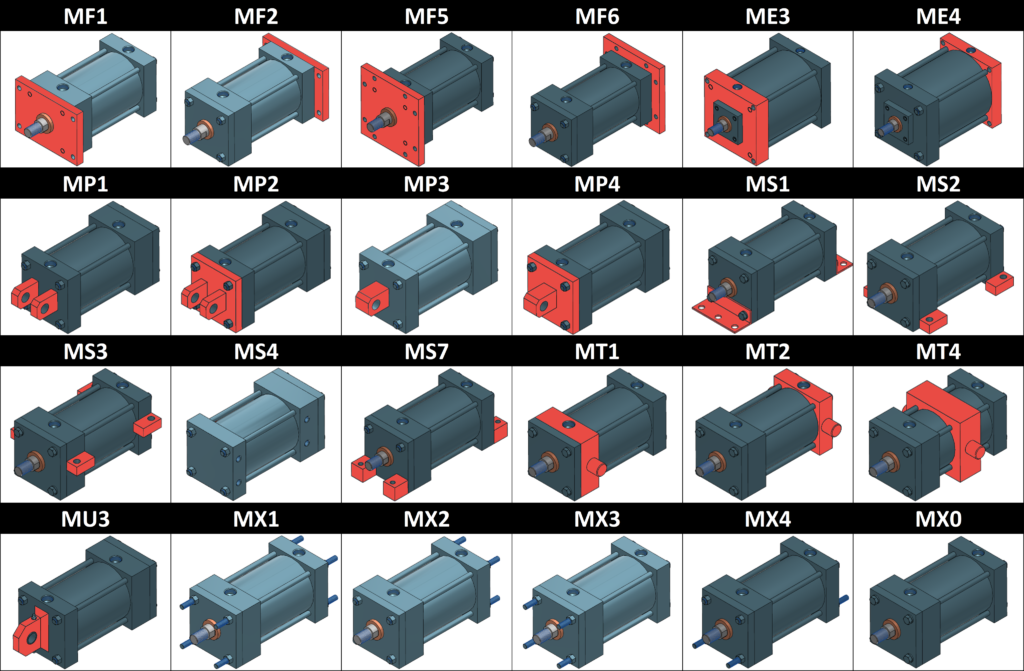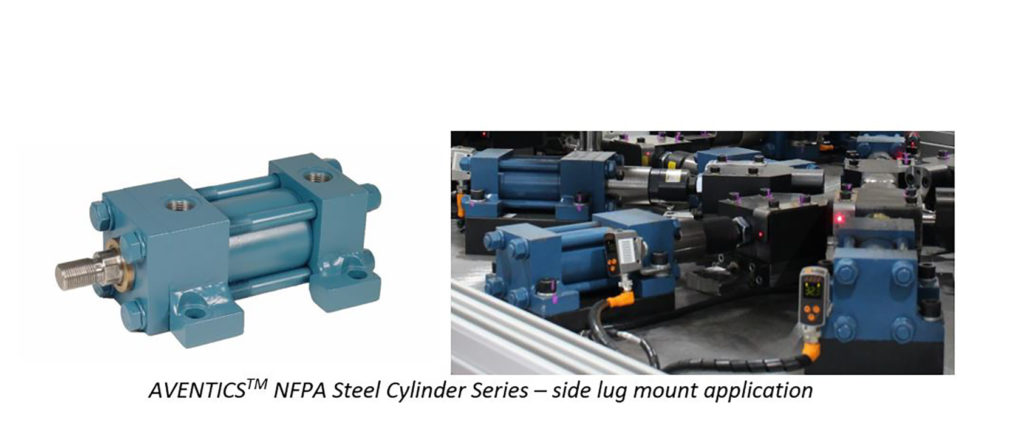How to Select the Best Mounting Configuration for Pneumatic Cylinders: Considerations for Optimum Performance
By Vitor Rangel, Product Marketing Specialist, Actuators, from Emerson
If you have chosen a pneumatic actuator properly sized for your application, now it’s time to decide how you are going to mount it. Selecting the best mounting configuration for your cylinder application is a critical design consideration to ensure optimum performance and maximize cylinder life expectancy.
To facilitate installation and worldwide interchangeability, most cylinder mounts are built to NFPA or ISO standards. Although numerous variations are available, mounting styles will typically fall into one of three main categories: fixed centerline mountings, fixed non-centerline mountings and pivoted centerline mountings.
When selecting the right mount for the application, the primary element to take into consideration is the application itself. In most cases, the intended function of the actuator and the application requirements or constraints will largely determine which mounting type to choose. Some key factors to consider are the cylinder stroke (long versus short), the plane of motion (horizontal, vertical or along a curved path), the size of the load and the load condition (guided versus nonguided), the column strength of the piston rod and the installation space. In some circumstances, the material the mounting is made of could potentially be relevant as well depending on its mechanical properties and the application environment.
It’s worth noting that all of these factors are also applicable to high-pressure hydraulic cylinders for which the operating pressure could also become a decisive factor. Certain cylinder mounts will have reduced pressure ratings to prevent premature failures associated with excessive shear and bending stresses that result from the high forces and operating pressures that can be conceived with such designs.
Like properly adjusting cushioning, if the mounting configuration is not carefully considered it can cause cylinders to fail prematurely. Therefore, we would like to provide you with some guidelines and best practices to help you avoid any problems associated with cylinder mounting.
Understanding Cylinder Mounting Terminology
In general, the codification of cylinder mounting types covered by NFPA and ISO standards will consist of two letters and a number as per the NFPA examples shown below:
Fixed centerline mountings – Mounting types MX1, MX2, MX3, MF1, MF2, MF5, MF6, ME3, ME4, MS3.
Fixed non-centerline mountings – Mounting types MS1, MS2, MS4, MS7
Pivoted centerline mountings – Mounting types MP1, MP2, MP3, MP4, MT1, MT2, MT4, MU3

The first letter indicates if it’s a mount (M) or an accessory (A) and the second letter designates the style:
B – body
E – head/cap
F – flange
P – pivot
R – threaded nose
S – foot or lugs
T – trunnion
X – studs or tie rods
Note: It’s also possible for mounting codifications to consist of 3 letters. This is a common practice among double rod configurations where the letter (D) is added to the standard designation (e.g. MDF1 – double rod cylinder with front flange mount).
Having covered the basics of mounting nomenclature, let’s now take a look at the distinct benefits and limitations of each of the main mounting categories.
Fixed centerline mountings
As the name suggests, fixed centerline mountings are best used in applications where the cylinder’s thrust is focused on the centerline of the cylinder rod. With the force focused this way, the cylinder may be attached at the head end or the cap end via square or rectangular flanges, extended tie rods or with centerline lugs (although this method is less commonly used). Fixed centerline mounts are suitable for straight-line force applications and tend to be more stable against sway on the power extension stroke. Flange mounts offer good strength and rigidity but low tolerance for misalignment whereas extended tie rod designs are less rigid but more modular, allowing for greater mounting flexibility.

When choosing a fixed centerline mounting, it’s important to be aware of a few additional things. To prevent misalignment and sagging under loads, one should attach the cylinder mount to a rigid structure (machine frame) and, if possible, ensure that the travel path of the rod end is linear and guided as this could also cause the pneumatic cylinder to jam. In the case of long stroke cylinders, the free end of the cylinder body may also require additional support to avoid some of the issues that were previously mentioned.
Fixed non-centerline mountings
In fixed non-centerline mountings, the thrust of the cylinder is aligned parallel to, but not on, the centerline of the cylinder rod. This mounting style is probably the easiest to mount and allows for simple, straightforward service and replacement. The cylinder may be attached via end lug mount, side lug mount or side tapped mount.

The offset thrust line of this mounting style does require special consideration as it places bending stresses and additional loads on the mounting bolts that can cause the bolts to wear or become loose over time. Therefore, to maximize service life and safety, this mounting must be very well aligned; the load should travel in a precise, linear path and be well supported and guided both horizontally and vertically. Rigid mounted cylinders cannot tolerate a consistent fixed misalignment, especially at full retraction. That being said, a minor misalignment that is zero at full retraction and increases very slightly with stroke is typically acceptable on heavy-duty constructions.
Pivoted centerline mountings
Pivoted centerline mountings are generally used in applications where the path of the load is curved or misalignment is an issue and cannot be avoided. With this mounting style, the centerline of the cylinder can swing in one or more directions with the major movement usually occurring in one plane. Clevis, eye and trunnion mounts are all examples of pivoted centerline mountings.

The clevis mount is one of the most versatile and widely used mounts, and it is best suited for short-stroke, medium or smaller bore cylinder applications. A trunnion mount, on the other hand, can be used in applications where the clevis mount would normally be used but would cause the overall length of the cylinder to be excessive.
For long stroke and/or heavy cylinders, the center or intermediate trunnion mount is best. In general, this mount supports the weight of the cylinder and should be located near the balance point of the cylinder at the time of maximum thrust.
The spherical mount is also a common and particular style of pivoted centerline mountings. Comprised of a spherical bearing, this mount allows for some angular movement (usually 5 to 10 degrees of motion) in a plane perpendicular to the major plane of pivot movement and should be used in conjunction with a grease fitting for maximum effectiveness and serviceability.
Last but not least, when considering pivoted centerline mounts, it is important to keep in mind that the rod end cylinder attachment should also be allowed to pivot, and it is best to use the cylinder manufacturer’s accessory brackets and close tolerance pivot pins to guarantee a proper fit and operation.
Additional considerations to optimize cylinder performance
As it has been alluded to throughout this article, to preserve the life of your cylinder and ensure top performance, it is very important to keep the cylinder thrust as close to the centerline of the piston rod as possible and free from misalignment or side thrust. Off-center thrust and side loads significantly shorten the anticipated rod bearing and rod seal service life and should be avoided at all costs.
In addition to the mounting style, there are several other aspects that should not be overlooked when installing a cylinder. Care should be taken to avoid damaging the exposed portion of the piston rod. Threaded pieces should be torqued to specification and pulled tight against thread shoulders to minimize bending and reduce fatigue stress. Excessive rotation of the piston rod within the cylinder should be avoided to prevent possible scoring of the cylinder tube and damage to the piston seals. Lastly, additional support or incorporation of an intermediate mount should be considered to prevent damaging sag on long stroke cylinders.
Emerson’s extensive, industry-leading portfolio of AVENTICSTM pneumatic and hydraulic cylinders addresses the performance and flexibility needs of your machine automation applications. Be sure to visit www.emerson.com/aventics to learn more about our offering.
